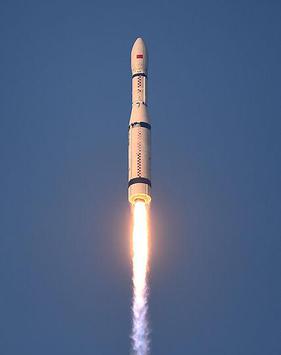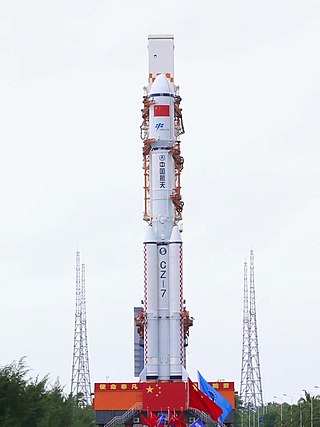Related Research Articles
The Long March rockets are a family of expendable launch system rockets operated by the China Aerospace Science and Technology Corporation. The rockets are named after the Chinese Red Army's 1934–35 Long March military retreat during the Chinese Civil War.
A liquid rocket booster (LRB) uses liquid fuel and oxidizer to give a liquid-propellant or hybrid rocket an extra boost at take-off, and/or increase the total payload that can be carried. It is attached to the side of a rocket. Unlike solid rocket boosters, LRBs can be throttled down if the engines are designed to allow it, and can be shut down safely in an emergency for additional escape options in human spaceflight.

The Long March 3A, also known as the Chang Zheng 3A, CZ-3A and LM-3A, is a Chinese orbital carrier rocket design. It is a 3-stage rocket, and is usually used to place communications satellites and Beidou navigation satellites into geosynchronous transfer orbits.
The Long March 1D was a member of China's Long March rocket family. During the 1990s CALT developed an improved version of the DF-4 to test the reentry vehicle warheads of the DF-31. They took advantage of this development and offered it as the Long March 1D for commercial application. The modifications included:
The Long March 2C (LM-2C), also known as the Chang Zheng 2C (CZ-2C), is a Chinese orbital launch vehicle, part of the Long March 2 rocket family. Developed and manufactured by the China Academy of Launch Vehicle Technology (CALT), the Long March 2C made its first launch on 9 September 1982. It is a two-stage launch vehicle with storable propellants, consisting of Nitrogen Tetroxide and Unsymmetrical Dimethylhydrazine. The launch vehicle was derived from the DF-5 ICBM.

The YF-73 was China's first successful cryogenic liquid hydrogen fuel and liquid oxygen oxidizer gimballed engine. It was used on the Long March 3 H8 third stage, running on the simple gas generator cycle and with a thrust of 44.15 kilonewtons (9,930 lbf). It had four hinge mounted nozzles that gimbaled each on one axis to supply thrust vector control and was restart capable. It used cavitating flow venturis to regulate propellant flows. The gas generator also incorporated dual heat exchangers that heated hydrogen gas, and supplied helium from separate systems to pressurize the hydrogen and oxygen tanks. The engine was relatively underpowered for its task and the start up and restart procedures were unreliable. Thus, it was quickly replaced by the YF-75.
The YF-75 is a liquid cryogenic rocket engine burning liquid hydrogen and liquid oxygen in a gas generator cycle. It is China's second generation of cryogenic propellant engine, after the YF-73, which it replaced. It is used in a dual engine mount in the H-18 third stage of the Long March 3A, Long March 3B and Long March 3C launch vehicles. Within the mount, each engine can gimbal individually to enable thrust vectoring control. The engine also heats hydrogen and helium to pressurize the stage tanks and can control the mixture ratio to optimize propellant consumption.
The YF-77 is China's first cryogenic rocket engine developed for booster applications. It burns liquid hydrogen fuel and liquid oxygen oxidizer using a gas generator cycle. A pair of these engines powers the LM-5 core stage. Each engine can independently gimbal in two planes. Although the YF-77 is ignited prior to liftoff, the LM-5's four strap-on boosters provide most of the initial thrust in an arrangement similar to the European Vulcain on the Ariane 5 or the Japanese LE-7 on the H-II.

The YF-100 is a Chinese liquid rocket engine burning LOX and kerosene in an oxidizer-rich staged combustion cycle.

This comparison of orbital launch systems lists the attributes of all individual rocket configurations designed to reach orbit. A first list contains rockets that are operational or in development as of 2022; a second list includes all retired rockets. For the simple list of all conventional launcher families, see: Comparison of orbital launchers families. For the list of predominantly solid-fueled orbital launch systems, see: Comparison of solid-fueled orbital launch systems.
The Long March 3B, also known as the CZ-3B and LM-3B, is a Chinese orbital launch vehicle. Introduced in 1996, it is launched from Launch Area 2 and 3 at the Xichang Satellite Launch Center in Sichuan. A three-stage rocket with four strap-on liquid rocket boosters, it is currently the second most powerful member of the Long March rocket family after the Long March 5 and the heaviest of the Long March 3 rocket family, and is mainly used to place communications satellites into geosynchronous orbits.

The Long March 6 or Chang Zheng 6 as in pinyin, abbreviated LM 6 for export or CZ 6 within China, is a Chinese liquid-fuelled launch vehicle of the Long March family, which was developed by the China Aerospace Science and Technology Corporation (CASC) and the Shanghai Academy of Spaceflight Technology (SAST). The rocket was developed in the 2000s, and made its maiden flight in 2015. As one of the new generation rocket family, the Long March 6 was designed to be a light capacity, "high-speed response" rocket, complementing the heavy lift Long March 5 and the mid-heavy lift Long March 7 rocket families. It is capable of placing at least 1,000 kg (2,200 lb) of payload into a Sun-synchronous orbit. The first stage of the Long March 6 was derived from the booster rockets being developed for the Long March 5 rocket. It is powered by a YF-100 engine, which generates 1,340 kN (300,000 lbf) of thrust from burning kerosene and LOX as rocket fuel and oxidiser. This was the first flight of the new engine design.

The Long March 7, or Chang Zheng 7 in pinyin, abbreviated LM-7 for export or CZ-7 within China, originally Long March 2F/H or Chang Zheng 2F/H, nicknamed Bingjian, is a Chinese liquid-fuelled launch vehicle of the Long March family, developed by the China Aerospace Science and Technology Corporation (CAST). It made its inaugural flight on 25 June 2016.
The RD-120 is a liquid upper stage rocket engine burning RG-1 and LOX in an oxidizer rich staged combustion cycle with an O/F ratio of 2.6. It is used in the second stage of the Zenit family of launch vehicles. It has a single, fixed combustion chamber and thus on the Zenit it is paired with the RD-8 vernier engine. The engine has been developed from 1976 to 1985 by NPO Energomash with V.P. Radovsky leading the development. It is manufactured by, among others, Yuzhmash in Ukraine.
The YF-115 is a Chinese liquid rocket engine burning LOX and kerosene in an oxidizer-rich staged combustion cycle. A high efficiency/high thrust environmental friendly rocket engine was always an objective within Programme 863. Development began in the 2000s, along with its sibling, the bigger YF-100, which would power the LM-5, LM-6 and LM-7 boosters and first stages. Testing was directed by the China National Space Administration (CNSA) commencing in 2005. Development works are mainly carried out by the Xi'an Aerospace Propulsion Institute. It will be used as upper stage engine for China's next generation of medium and light environmental-friendly launch vehicles, namely the Long March 6 and the Long March 7. During early 2012, the engine system successfully passed vacuum testing. It is China's first upper stage rocket engine to adopt the staged-combustion cycle.
The YF-75D is a liquid cryogenic rocket engine burning liquid hydrogen and liquid oxygen in a closed expander cycle. It is China's third generation of upper stage cryogenic propellant engine, after the YF-73 and the YF-75. It is used in a dual engine mount in the H5-2 second stage of the Long March 5 launch vehicles. Within the mount, each engine can gimbal individually to enable thrust vectoring control. As its predecessor, the YF-75 it can adjust its mixture ratio to optimize propellant consumption. But as an additional improvement, it can do multiple restarts, against the single one of its predecessor.

The YF-20 is a Chinese liquid-fuel rocket engine burning N2O4 and UDMH in a gas generator cycle. It is a basic engine which when mounted in a four engine module forms the YF-21. The high altitude variation is known as the YF-22 is normally paired with the YF-23 vernier to form the YF-24 propulsion module for second stages. New versions when used individually for booster applications are called YF-25.
The YF-23 is a liquid rocket vernier engine, burning N2O4 and UDMH. It is used in along the YF-22 to form the YF-24 and YF-25 propulsion modules.
The YF-1 was a Chinese liquid rocket engine burning N2O4 and UDMH in a gas generator cycle. It is a basic engine which when mounted in a four engine module forms the YF-2. It was used as the basis for developing a high altitude version known as the YF-3.
The FG-36 was a Chinese spin stabilized apogee kick motor burning HTPB. It was developed by China Hexi Chemical and Machinery Corporation for use in the Fengyun 2 satellite bus for insertion into GSO orbit.
References
- 1 2 "Long March". Rocket and Space Technology. Retrieved 2015-07-08.
- ↑ "YF-40". Encyclopedia Astronautica. Archived from the original on 2015-08-24. Retrieved 2015-07-15.
- 1 2 Gunter Dirk Krebs. "CZ-4 (Chang Zheng-4)". Gunter's Space Page. Retrieved 2015-07-15.
- ↑ Sutton, George Paul (November 2005). "Liquid Rocket Propellant Engines in the People's Republic of China". History of Liquid Propellant Rocket Engines. AIAA. p. 873. ISBN 978-1563476495 . Retrieved 2015-07-15.
- ↑ Mowthorpe, Matthew (2004). "Chinas Military Space Program". The Militarization and Weaponization of Space. Lexington Books. p. 90. ISBN 978-0739107133 . Retrieved 2015-07-15.
- 1 2 "Chang Zheng-1 (Long March-1)". SinoDefence. Archived from the original on 2015-07-16. Retrieved 2015-07-15.
- ↑ Harvey, Brian (2004). "Launch Centers Rockets and Engines". China's Space Program — From Conception to Manned Spaceflight. Springer Science & Business Media. p. 231. ISBN 978-1852335663 . Retrieved 2015-07-15.
